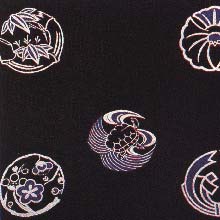Dye (p. 116 )
1. Produced in Izumo City, Shimane Prefecture.
2. Characteristics: A traditional "Furoshiki"(square wrapping cloth) used as one of the items for the bride to take with her to her groom. It was dyed in indigo with a cylinder("Tsutsugaki"). In the center of the fulled cotton cloth is dyed the brideユs family crest and at the 2 or 4 corners are dyed such felicitous designs as "Sho-Chiku-Bai"(Pine, Bamboo, Plum), "Tsuru-Kame"(Crane, Turtle), or "Takara Zukushi"(collection of figures symbolical of health and wealth). There is also a set of 3 different sizes of the Furoshiki. The dyer who dyes the wrapping cloth was called "Omote(front) Konya" and those who dyed the threads "Ito(thread) Konya."
3. Uses: Wedding purposes
4. History: It is surmised that cotton growing flourished in the late Edo Period. Although the quality of indigo produced in this area was not as good as those in Awa(Tokushima Prefecture), indigo dyeing was important for farmers in mountain villages as the indigo strengthened the cloth and were insect repellent. The indigo dyed cloths were important for the people in Izumo because it was widely used as one of the bridal items, and as bath cloths for babies, as a strap with which to carry baby on the back, and for banners for hoisting on Boyユs Day Festivals. Such customs have ceased, and now only 2 dyers left.
Dyeing Method
Indigo and other plants are used as dyes. The cloths are usually dyed all over in indigo. When multi-colored, designs are dyed separately with pigments. Designs are decided by the person who orders.



